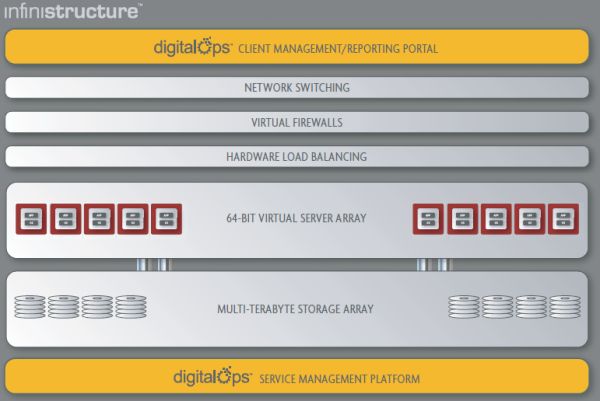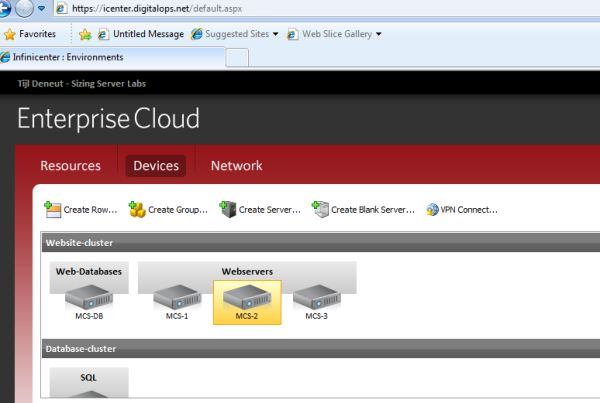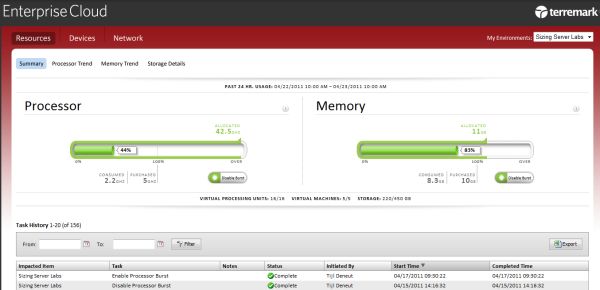Infrastructure as a Service: Benchmarking Cloud Computing
by Johan De Gelas on June 2, 2011 8:50 PM EST- Posted in
- IT Computing
- IT Computing general
- Cloud Computing
Terremark’s Enterprise Cloud
Terremark’s Enterprise Cloud is based on the “Infinistructure” platform, a mix of servers, storage, and networking with a self-service portal digitalOps. The software part of the Infinistructure Utility Computing platform is based upon VMware’s vSphere virtualization platform and makes use of vMotion, load balancing and Dynamic Resource Scheduling (DRS).
You can create a server in a few minutes by using the templates that Terremark provides (“Create Server”). This instructional movie gives a quick overview how this is done. It is a simple and straightforward process that takes 10-15 minutes at most.
The digitalOps environment interface has three tabs: Resources, Devices, and Network. The Devices tab lists all the virtual machines you have created so far. The virtual machines can be sorted/grouped as you can see below.
Creating servers (using the “Create Server” option) from the Terremark templates was very easy, but the "Create Blank Servers" option was a different story. It was not possible to mount our own ISOs. According to Terremark, this will be fixed in the next release, as you will be able to import your own Open Virtualization Format (OVF) virtual machine. Installing ISOs will not be possible yet.
The Resources tab gives you the real “cloud computing” or “IaaS” feel. Your “cloud data center” is a collection of a specified amount of processor GHz, several gigabytes of memory space, and storage usage. You also get a summary of how much of those resources you have used the past 24 hours.













29 Comments
View All Comments
benwilber - Friday, June 3, 2011 - link
this is a joke, right?there is not one bit of useful information in this article. if i wanted to read a Terremark brochure, i'd call our sales rep.
speaking as an avid reader for more than 12 years, it's my opinion that all these braindead IT virtualization articles are poorly conceived and not worthy of anandtech.
krazyderek - Friday, June 3, 2011 - link
submit a better one thenDigitalFreak - Friday, June 3, 2011 - link
I guess it's a good thing then that your opinion doesn't matter.HMTK - Monday, June 6, 2011 - link
Yeah, I also prefer yet another vidcard benchmark fest.Not.
Shadowmaster625 - Friday, June 3, 2011 - link
Still waiting for that $100 tablet that can provide me a remote desktop that is so responsive you cant even tell it is a remote desktop. I want it to be able to stream video at 480p. With good compression, this only requires a 1 mbps connection. I dont think this is too much to ask for $100. I dont care that much about HD. Streaming a desktop at 30 fps should only require a small fraction of my bandwidth.tech6 - Friday, June 3, 2011 - link
As you mentioned, Terremark cloud benchmarks vary greatly depending on the underlying hardware. We did some tests on their Miami cloud last year and found the old AMD infrastructure to be a disappointing performer. The software is very clever but, like all clouds, some benchmarking and asking the right questions is essential before making a choice.duploxxx - Sunday, June 5, 2011 - link
as usual this is very debatable information you provide. How did you bench and what storage platform? what is your compare a 2008 vs 2010? What kind of application did you bench? Specint? :) Just like Anandtech has greatly shown in the past is that appplications performance can be influenced by the type of cpu (look at the web results within the vApp that is clearly showing it likes faster cache architecture and to certain extend influences the final vApp result to much) you need to look at the whole environment and applications running in the environment, this requires decent tools to benchmark your total platform. (We have more code written by dev to automaticaly test any functional and performance aspect then the applications by themselves) everything in a virtual layer can influence the final performance.Our company has from 2005 till now always verified the platforms between intel and AMD on virtualization every 2 and 4 socket machine. Currently approx 3000 AMD servers on line all on Vmware private clusters from many generations. They are doing more then fine. The only timeframe that the Intel was faster and a better choice was just at launch time of the Nehalem Xeon for a few months. Offcourse one also need to look at the usecase for example the latest Xeon EX is very interesting with huge amount of small vm's, but requires way more infrastructure to handle for example load and the failure of a server. (Not to mention license cost from some 3th party vendors like Oracle.....)
lenghui - Friday, June 3, 2011 - link
A very well thought-out comparison betwen the in-house and IaaS environments. Even those who have the in-house resources would need to spend a lot of research time to reach a conclusion. In that sense, your review is most invaluable -- saving hundreds of hours or otherwise guess work for your readers. You probably can include a price analysis as the other readers have suggested.Thanks, Johan, for the great article.
brian2p98 - Friday, June 3, 2011 - link
This is, imo, the biggest unknown with cloud computing--and the most critical. Poor performance here could result in degradation of performance on the scale of several orders of magnitude. Website hosting, otoh, is rather straightforward. Who cares if 5Ghz of cloud cpu power is equivalent to only 1Ghz of local, so long as buying 25Ghz still makes economic sense?duploxxx - Sunday, June 5, 2011 - link
depends on how good or bad your app can scale with cpu cores.....if it doesn't and you need more vm's to handle the same load you also need other systems to spread the load between apps.